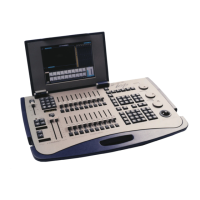
Do you have a question about the Compulite Spark and is the answer not in the manual?
| Number of Channels | 512 |
|---|---|
| Display | LCD |
| Control Protocols | DMX512 |
| Power Supply | 100-240V AC, 50/60Hz |
| Operating Temperature | 0°C to 40°C |
Instructions for initial system configuration, including hardware setup and software setup.
Overview of the Spark editor, its keys, modes, and display elements.
Explanation of Soft Key modes, default and temporary assignments, and LED color codes.
Details on controlling the video display, available formats, and key functions for navigation.
Describes display formats for channels and spots, including scroller and parameter information.
Step-by-step guide for initial setup of the Spark system, including connections and configuration.
Covers single, multiple, and range selections of channels, including editor and on-stage grabbing.
Details on assigning dimmer levels using wheels, keys, or the '@' symbol.
Instructions for selecting and assigning frame values to scrollers, and releasing them from memories.
Guide to selecting spots, including default selection, single/multiple selections, and recalling last selections.
Explanation of spot parameters, parameter wheels, types of parameters, and assigning values.
Core process of programming memories by assigning numbers, values, and storing the lighting state.
How to copy channel intensities, scroller frames, and spot parameters from various sources.
Details on assigning time-in, time-out, delay, wait-in, and wait-out times to memories.
Explanation of loop functions for repetitive playback, including types and programming.
How to link memories for sequential playback regardless of numerical order.
Steps for editing stored memories, including selecting, modifying, and storing.
Modifying assignments on playback devices and creating libraries using the STORE STORE function.
Storing modifications to apply to memory changes, including relative and absolute delta tracking.
Instructions for saving the entire system configuration to a diskette.
Process for loading show files from disk, including options for partial loads.
Options for printing documentation, including memory sheets and contents.
Introduction to the A/B crossfader, its function, assignments, and playback modes.
How to assign memories or editor groups to the A/B crossfader for playback.
Enabling and disabling memory sequencing on the crossfaders.
Introduction to Spark's 20 controllers, their features, and assignment capabilities.
How to assign memories to controllers manually or automatically.
Explanation of chaser functions, playback modes, and assigning chasers to controllers.
Determines which playback devices control output, affecting spots and scrollers.
Control priority where the last activated controller has the highest priority.
Introduction to libraries for moving lights, including position, color, and gobo assignments.
Instructions for creating and programming libraries for spots.
How to modify libraries, add/remove spots, and update using STORE STORE.
Introduction to memory parts, dividing memories, and assigning times.
How to assign parts to channels, scrollers, and spots during memory programming.
Selecting and modifying parts within a memory, including removing assignments.
Introduction to Events, their triggers, and programming methods.
Methods to operate events, including assigning to memories or directly through the editor.
Explanation of Snaps as snapshots of playback device assignments for instant recall.
Details on operating Snaps in non-forcing and forcing modes.
Introduction to Macros as collections of keystrokes for automating functions.
Instructions for selecting and programming Macro numbers and sequences.
Methods for operating Macros via Soft Keys, numeric keypad, or Events.
Steps to access Service Tools for system configuration, disk operations, and software upgrades.
Details on setting up system configuration parameters like control capacity and special functions.
Configuration of operator-definable parameters affecting default memory time, trackball sensitivity, etc.
Options for soft-patching dimmers, channels, assigning curves, and managing GM control.
Instructions for patching dimmers to control channels.
Tools for scroller management, including patching to channels and DMX addresses.
Tools for managing moving lights, including device definitions and output addresses.
Assigning device types to spot numbers and managing DMX addresses.
Configures beam movement for consistent trackball operation, regardless of spot orientation.
Steps to enable MIDI communication and define the MIDI channel.
Functionality to synchronize consoles using MIDI commands.
Setting up external SMPTE generator connection and DMX input.
Assigning time codes to Events using the 'teach' function.
Enabling and configuring DMX input channels for channels, spots, and macros.
Table for patching DMX input channels to control channels or macros.
Assigning DMX input channels to control Spark channels.
Steps to access Service Tools for configuration, disk operations, and software upgrades.
Running hardware tests for panel, keyboard, and memory.
Instructions for upgrading system software via diskette.
Functions for formatting diskettes, recording, and loading system configuration.
Overview of Patch 999 for mapping logical channels to DMX addresses.
Steps to enable and configure Patch 999 in Service Tools.
Process for editing, copying, and flashing Patch 999 to the console.